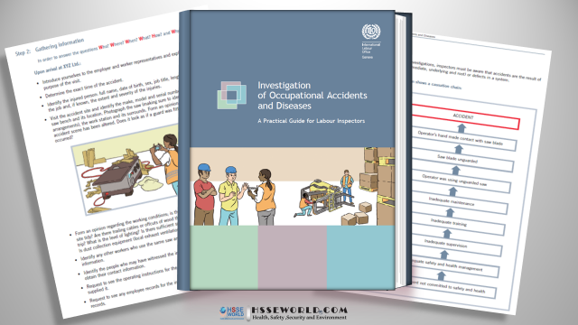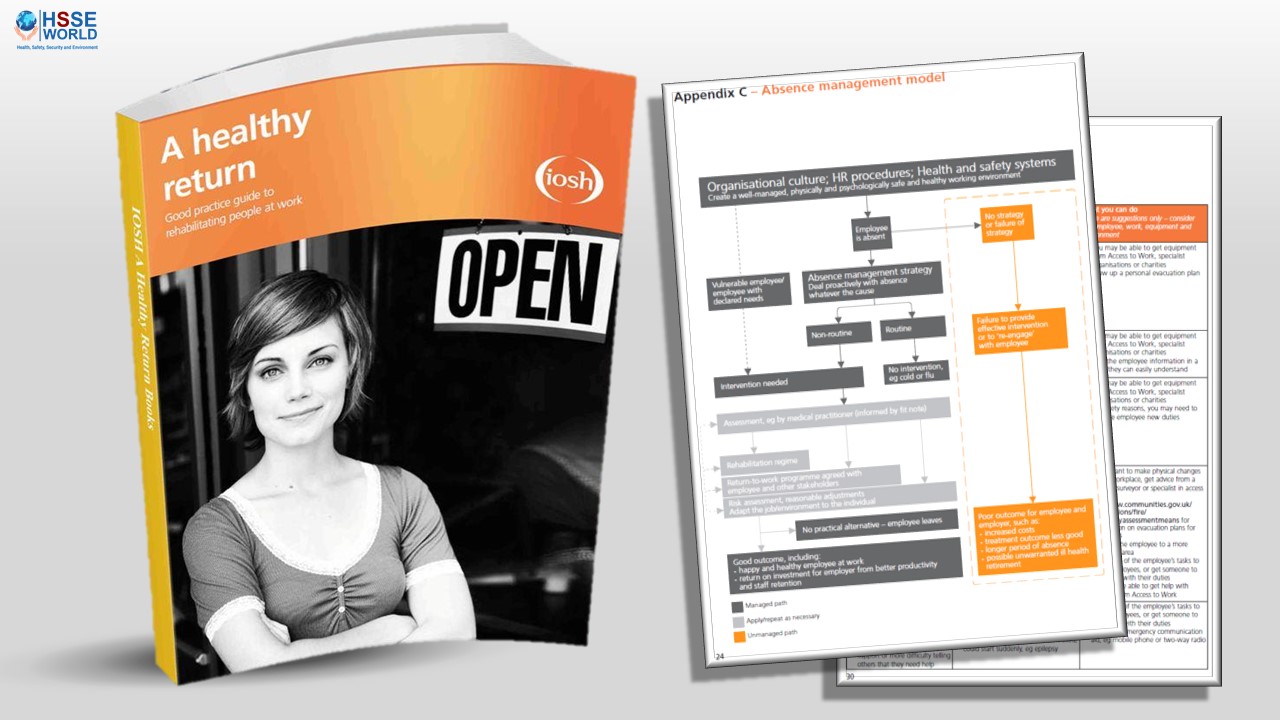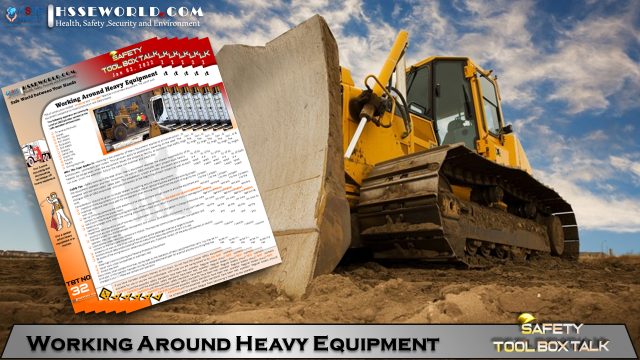Investigation of Occupational Accidents and Diseases Is a Practical Guide for Labour Inspectors designed to equip labour inspectors with the necessary skills to conduct
effective investigations into occupational accidents, occupational diseases, and other undesired events (such as dangerous occurrences and near-miss/incidents) that could have led to personal injuries affecting workers or members of the public. It should be borne in mind that occupational accidents, diseases and other undesired events are preventable.
Conducting an effective investigation will identify not only causal factors but actions that would have prevented the event from occurring.
The guide provides inspectors with information on the importance of, and a suggested methodology for, conducting effective investigations and compiling reports. While the ILO understands that other methodologies for conducting investigations are available, it believes that following the methodology presented below will help inspectors to identify all the immediate and root causes of the event under investigation. This, in turn, will enable inspectors to help employers, enterprises, and worker representatives to identify appropriate prevention/risk control measures to prevent a recurrence of the actions
that led to the event being under investigation, thereby improving occupational safety and health (OSH) management.
The guide was developed in conjunction with the ILO International Training Centre in Turin following a workshop on conducting occupational accident and disease investigations,
which was attended by constituents from Brazil, Italy, Norway, Portugal, Romania, The United Kingdom and the United States of America and technical specialists from the
Labour Administration, Labour Inspection and Occupational Safety and Health Branch of
the international labour office.
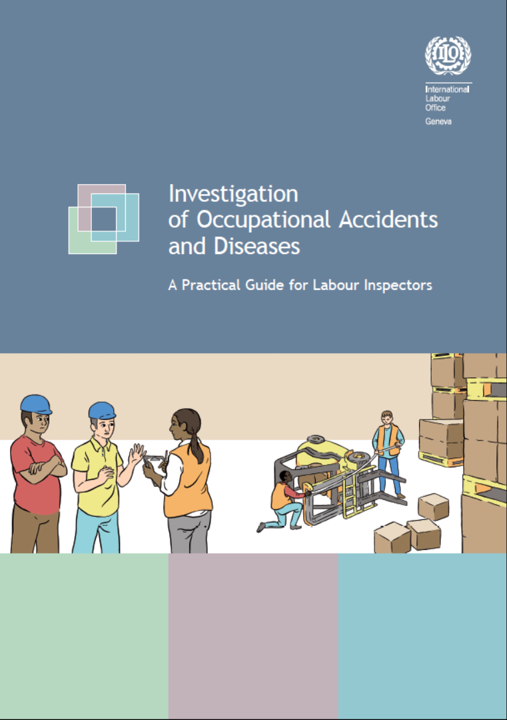
Investigation of Occupational Accidents and Diseases Book’s cover
What is an investigation?
An investigation into an occupational accident, disease or dangerous occurrence (near-miss)
- identifies how and why an undesired event (accident, contraction of a disease, dangerous occurrence, near miss) occurred; and
- establishes actions required to prevent a similar event, thereby leading to an improvement in occupational safety and health management.
- Investigations carried out by labour inspectors should also identify, with regard to the event under investigation:
- all those with legal obligations – e.g. the enterprise, managers, workers, suppliers etc.;
- the applicable legislation, whether it has been violated and any associated enforcement decisions; and
- actions required to ensure that the enterprise complies with all relevant OSH legislation.
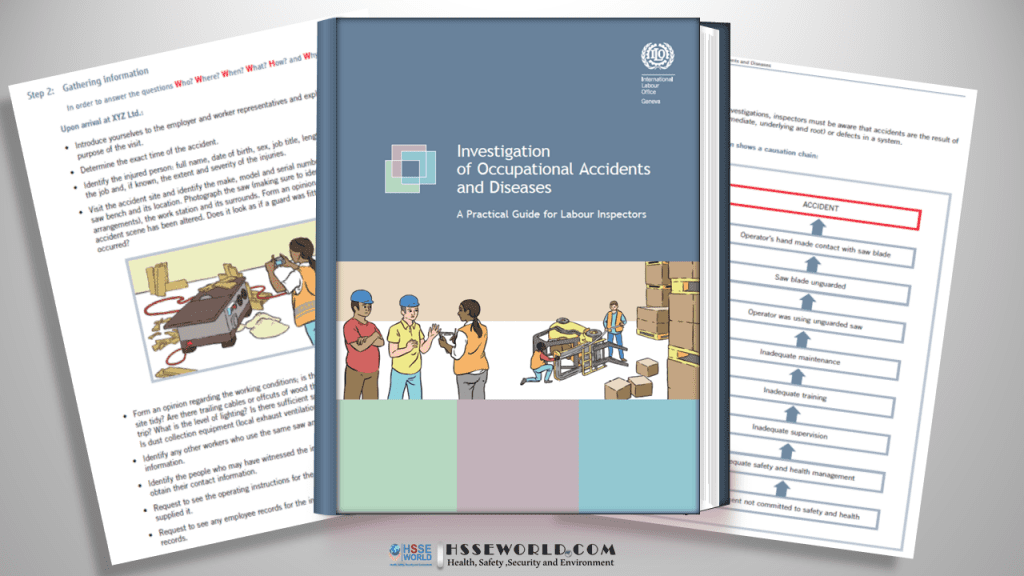
The investigation is reactive because an event must occur before it can be investigated. The labour inspector must determine not only what the result of the event was, but also how and why it occurred so that control (safety) measures can be identified and implemented to prevent its recurrence, thereby improving safety and health management. In addition, part of the inspector’s job is to ensure that employers and workers comply with national legislation, including OSH legislation, legal issues relating to the investigation must be addressed.
Any investigation must answer six basic questions, the 5Ws and 1H:
Who was injured, suffered ill health or was otherwise involved in the event under investigation?
Where did the accident occur?
When did the accident occur?
What happened at the time of the accident?
How did the accident occur?
Why did the accident occur?
Contents
The Contents of Investigation of Occupational Accidents and Diseases
- Abbreviations IV
- Definitions IV
- Preface V
- Introduction 1
1.1 What is an investigation? 1
1.2 What makes a good investigation? 2
1.3 What gets investigated? 5 - Skills required by investigators7
2.1 Interviewing skills 8
2.2 Questioning witnesses 10 - Main stages of an accident investigation 13
3.1 Preparations before starting the investigation13
3.2 Gathering information15
Arrival at the site19
Prior to leaving the site20
3.3 Analysing the information21
3.4 Identifying preventive/risk control measures25
3.5 Implementing an action plan 26
3.6 Completing the report/documenting the information27 - Accident investigation checklist29
- Investigation report 33
Case study: Employee injured while operating a circular saw bench37
Step 1: Actions to take upon receiving notification of the accident 37
Step 2: Gathering information38
Step 3: Analysing the information43
Step 4: Identifying preventive/risk control measures45
Step 5: Implementing an action plan46
Step 6: Investigation report 46
Download the book
Investigation of Occupational Accidents and Diseases
More Downloads
- E-Books: Healthcare Hazard Control & Safety Management
- E-Books: Safety, Health and Working Conditions Training Manual
- E-Books: Energy Efficiency in Water and Wastewater Facilities
- E-Books: Fire Service Features of Buildings and Fire Protection Systems
- E-Books: Evaluation of Fire Safety free download
- E-Books: PPE for Chemical, Biological, and Radiological Hazards free
- E-Books: Changing the Workplace Safety Culture free download
- E-Books: Site Emergency Planning Workbook
- E-Books: Load Restraint Guide
- E-Books: Essential Practices for Creating, Strengthening, and Sustaining Process Safety Culture
- E-Books: System Safety Engineering and Risk Assessment
- E-Books: Permit-Required Confined Spaces
- E-Books: Is it Safe to Enter Confined Space?
- E-Books: 5-Minute Workplace Safety Talks
- E-Books: Safety Culture and High-Risk Environments
- E-Books: Practical Guide to Industrial Safety
- E-Books: Slip, Trip, and Fall Prevention for Healthcare Workers
- E-Books: Health and Safety at Work Key Terms
- E-Books: Fundamentals of Process Safety Engineering
- E-Books: Gas Detection Hand Book
- E-Books: Occupational health and safety management systems ANSI-AIHA-z10-2012
- E-Books: Hot Work on Drums and Tanks
- E-Books: Human Fatigue Risk Management
- E-Books: Guidelines for the provision of facilities and general safety in the construction industry
- E-Books: Handbook of Training in Mine Rescue and Recovery Operations ( 2021)
- E-Books: Code of Practice for the Safe Use of Lifting Equipment – Edition 9 (Nov 2019)
- E-Books: Free Forklift Health and Safety Best Practices Guideline
- E-Books: Handbook of Hazardous Chemical Properties
- E-Books: Human Performance Improvement through Human Error Prevention
- E-Books: Principles Of Fire Risk Assessment In Buildings
- E-Books: Investigation of Occupational Accidents and Diseases
- E-Books: Radiation Protection and Safety in Industrial Radiography
- E-Books: Basic Guide to System Safety, Third Edition
- E-Books: Food Safety Management-A Practical Guide for the Food Industry
- E-Books: Safety identification: Escape and evacuation plan signs- ISO 23601
- E-Books: Safety at Work
- E-Books: The Safety-Critical Systems Handbook 4th edition
- E-Books: Fundamental principles of occupational health and safety
- E-Books: Fire Safety Risk assessment Guide – Sleeping Accommodation
- E-Books: Mental health at work series
- E-Books: Live Fire Training: Principles and Practice
- E-Books: Pre-Startup Safety Review Guide
- E-Books: Fire and Emergency Drill Manual and Building Inspection Guide
- E-Books: Health and Safety: Risk Management 5th edition
- E-Books: Fire Protection systems -Third edition 2021
- E-Books: Fire Safety Logbook templates
- E-Books: From Accidents to Zero
- E-Books: Electric Safety Practice and Standards
- Your steps to chemical safety
- E-Books: Ergonomics and Psychology Developments in Theory and Practice
- E-Books: HAZOPS Should BE fun-The Stream-Based HAZOP
- E-Books: Safety Health and Environmental Auditing
- E-Books: A Quick Guide to Health and Safety
- E-Books: Occupational Ergonomics A Practical Approach
- E-Books: Job Hazard Analysis A Guide for Voluntary Compliance and Beyond
- E-Books: Electrical Safety of Low Voltage Systems

